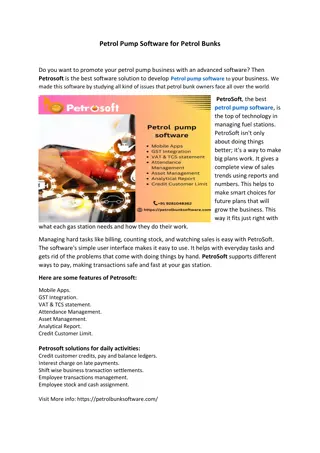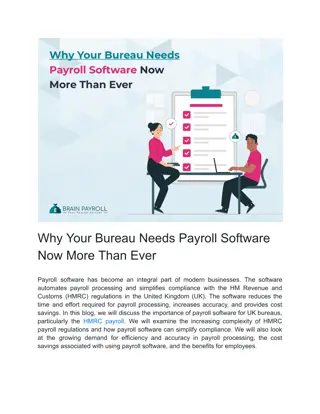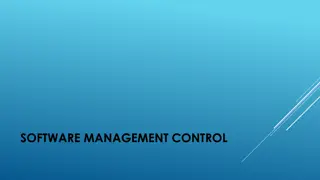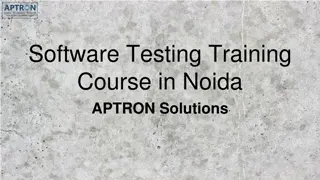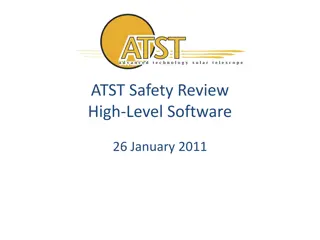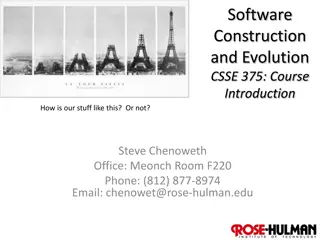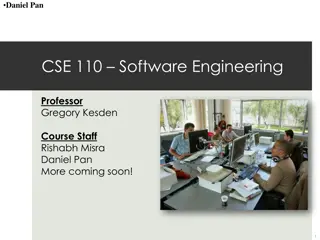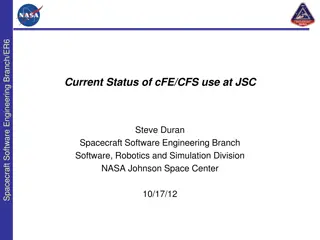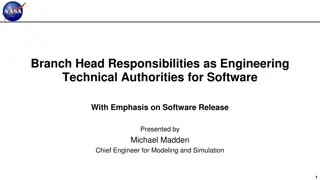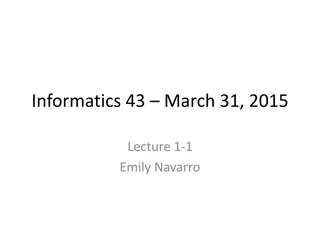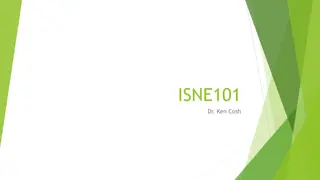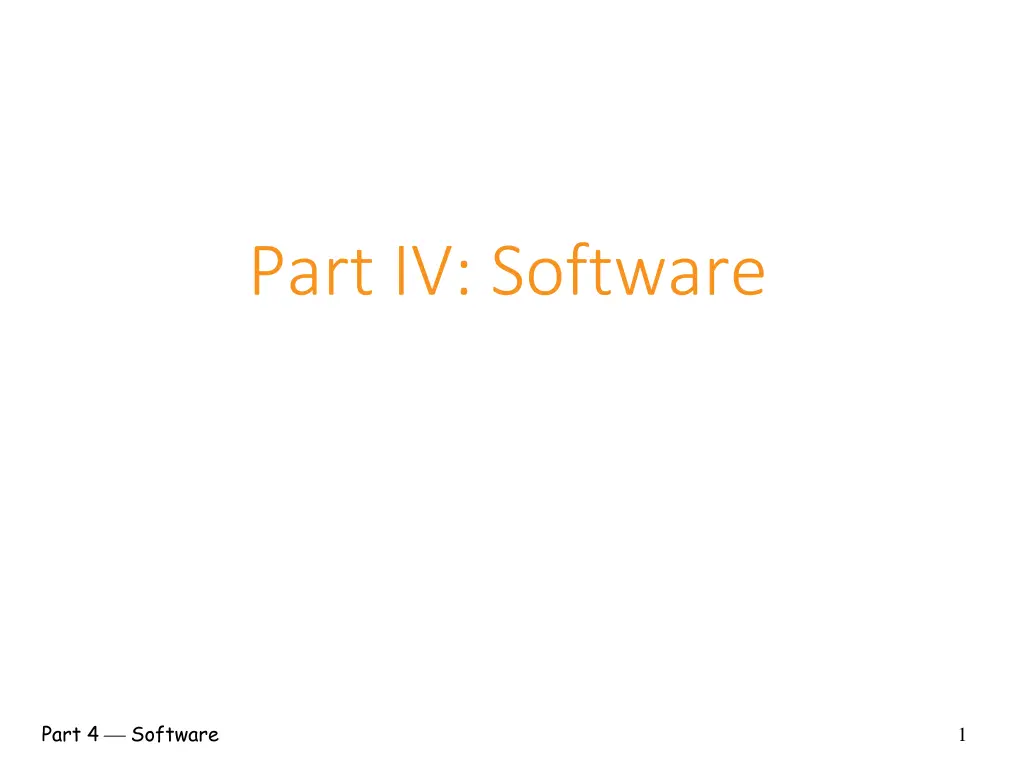
Importance of Software in Information Security
Discover why software plays a crucial role in ensuring information security, as vulnerabilities in software can compromise the best encryption, access control, and protocols. Explore real-world examples of software failures and understand the impact of software flaws and malware on security.
Uploaded on | 3 Views
Download Presentation

Please find below an Image/Link to download the presentation.
The content on the website is provided AS IS for your information and personal use only. It may not be sold, licensed, or shared on other websites without obtaining consent from the author. If you encounter any issues during the download, it is possible that the publisher has removed the file from their server.
You are allowed to download the files provided on this website for personal or commercial use, subject to the condition that they are used lawfully. All files are the property of their respective owners.
The content on the website is provided AS IS for your information and personal use only. It may not be sold, licensed, or shared on other websites without obtaining consent from the author.
E N D
Presentation Transcript
Part IV: Software Part 4 Software 1
Why Software? Why is software as important to security as crypto, access control, protocols? o Virtually all information security features are implemented in software o If your software is subject to attack, your security can be broken Regardless of strength of crypto, access control, or protocols o Software is a poor foundation for security Bad Software is Bad Software is Ubiquitous ( Ubiquitous (found everywhere found everywhere) ) o NASA Mars Lander (cost $165 million) Crashed into Mars due to error in converting English and Metric units of measure o Denver airport Baggage handling system very buggy software Delayed airport opening by 11 months Cost of delay exceeded $1 million/day What happened to person responsible for this fiasco? o What about the recent Boeing 737 MAX 8 crashes?? flight control operations MCAS System Part 4 Software 2
Chapter 11: Software Flaws and Malware If automobiles had followed the same development cycle as the computer, a Rolls-Royce would today cost $100, get a million miles per gallon, and explode once a year, killing everyone inside. Robert X. Cringely My software never has bugs. It just develops random features. Anonymous Part 4 Software 3
Software Issues Alice and Bob Find bugs and flaws by accident Hate bad software but they learn to live with it Must make bad software work Trudy Actively looks for bugs and flaws Likes bad software and tries to make it misbehave Attacks systems via bad software System Lines of Code (LOC) Complexity is the enemy of security , Paul Kocher, Cryptography Research, Inc. Netscape 17 million Space Shuttle 10 million Linux kernel 2.6.0 5 million Nowadays, a new car contains more LOC than was required to land the Apollo astronauts on the moon Windows XP 40 million Mac OS X 10.4 86 million Boeing 777 7 million Part 4 Software 4
Lines of Code and Bugs Conservative estimate: 5 bugs/10,000 LOC Do the math Typical computer: 3000 exe s of 100,000 LOC each Conservative estimate: 50 bugs/exe Implies about 150,000 bugs per computer So, 30,000-node network has 4.5 billion bugs Maybe only 10% of bugs security-critical and only 10% of those remotely exploitable Then only 45 million critical security flaws! o o o o o o Software Security Topics o Program flaws (unintentional) Buffer overflow Incomplete mediation Race conditions o Malicious software (intentional) Viruses Worms Other breeds of malware Part 4 Software 5
Program Flaws An error is a programming mistake o Made by human/programmer An error may lead to incorrect state: fault o A fault is internal to the program A fault may lead to a failure, where a system departs from its expected behavior o A failure is externally observable error fault failure Example This program has an error This error might cause a fault o Incorrect internal state If a fault occurs, it might lead to a failure o Program behaves incorrectly (external) We use the term flaw for all of the above char array[10]; for(i = 0; i < 10; ++i) array[i] = A ; array[10] = B ; Part 4 Software 6
Secure Software In software engineering, try to ensure that a program does what is intended Secure software engineering requires that software does what is intended and nothing more o Absolutely secure software? Dream on o Absolute security anywhere is impossible How can we manage software risks? Program Flaws o Program flaws are unintentional But can still create security risks o We ll consider 3 types of flaws 1. Buffer overflow (smashing the stack) 2. Incomplete mediation 3. Race conditions o These are the most common flaws Part 4 Software 7
1. Buffer Overflow Part 4 Software 8
1. Buffer 1. Buffer Overflow: Attack Overflow: Attack Scenario Scenario Users enter data into a Web form Web form is sent to server Server writes data to array called buffer, without checking length of input data Data overflows buffer o Such overflow might enable an attack o If so, attack could be carried out by anyone with Internet access Buffer Overflow Q: What happens when code is executed? int main(){ int buffer[10]; buffer[20] = 37; } A: Depending on what resides in memory at location buffer[20] o Might overwrite user data or code o Might overwrite system data or code o Or program could work just fine Part 4 Software 9
Simple Buffer Overflow Consider boolean flag for authentication Boolean flag Buffer overflow could overwrite flag allowing anyone to authenticate buffer F O U R S C F T In some cases, Trudy need not be so lucky as in the above example Memory Organization o Text code o Data static variables o Heap dynamic data o Stack scratch paper Dynamic local variables Parameters to functions Return address low address text data heap stack pointer (SP) stack high address
Memory Layout of a C Program low address text #include <stdio.h> #include <stdlib.h> Initialized data int x; int y = 15; uninitialized data int main(int argc, char* argv[]) { int *value; int i; value = (int*) malloc(sizeof(int)*5); for(i=0; i < 5; i++) value[i] = i; heap return 0; } stack pointer (SP) stack argc, argv high address
Simplified Stack Example low :: void func(int a, int b){ char buffer[10]; } void main(){ func(1,2); } SP buffer return address SP SP ret a b SP high Part 4 Software 12
Smashing the Stack low What happens if buffer overflows? :: ??? Program returns to wrong location SP buffer ret SP NOT! overflow overflow ret A crash is likely SP a b SP high Part 4 Software 13
Smashing the Stack low Trudy has a better idea :: Code injection Trudy can run code of her choosing o on your machine SP evil code SP ret ret SP a b SP high Part 4 Software 14
Smashing the Stack :: Trudy may not know 1) Address of evil code 2) Location of ret on stack Solutions 1) Precede evil code with NOP landing pad 2) Insert ret many times NOP : NOP evil code ret ret ret : ret :: Part 4 Software 15
Summary Summary: Stack Smashing A buffer overflow must exist in the code Not all buffer overflows are exploitable o Things must align properly If exploitable, attacker can inject code Trial and error is likely required o Fear not, lots of help is available online o Smashing the Stack for Fun and Profit, Aleph One Stack smashing is attack of the decade o for many recent decades o Also heap & integer overflows, format strings, etc. Part 4 Software 16
Example Example: Stack Smashing Suppose program asks for a serial number that Trudy does not know Also, Trudy does not have source code Trudy only has the executable (exe) Program quits on incorrect serial number By trial and error, Trudy discovers apparent buffer overflow Note that 0x41 is ASCII for A (6510=0100 00012=4116) Looks like ret overwritten by 2 bytes!
Disassemble Code Next, disassemble bo.exe to find The goal is to exploit buffer overflow to jump to address 0x401034 Part 4 Software 18
Buffer Overflow Attack Find that, in ASCII, 0x401034 is @^P4 Byte order is reversed? What the X86 processors are little-endian Reverse the byte order to 4^P@ and Success! We ve bypassed serial number check by exploiting a buffer overflow What just happened? o Overwrote return address on the stack
Buffer Overflow Trudy did not require access to the source code Only tool used was a disassembler to determine address to jump to Find desired address by trial and error? o Necessary if attacker does not have exe o For example, a remote attack Source code for buffer overflow example Flaw easily exploited by attacker without access to source code! #include<stdio.h> #include<string.h> void main() { char in[75]; printf("\nEnter Serial Number\n"); scanf("%s", in); if(!strncmp(in,"S123N456", 8)) { printf("Serial number is correct.\n"); } } Part 4 Software 20
Stack Smashing Stack Smashing Defenses Employ non-executable stack No execute NX bit (if available) Seems like the logical thing to do, but some real code executes on the stack (Java, for example) Defenses o o Use a canary low Address Space Layout Randomization (ASLR) :: Use safe languages (Java, C#) Use safer C functions o For unsafe functions, safer versions exist o For example, strncpy instead of strcpy Canary buffer canary overflow o Run-time stack check o Push canary onto stack o Canary value: Constant 0x000aff0d Or, may depends on ret overflow ret a b high Part 4 Software 21
Microsofts Canary Microsoft added buffer security check feature to C++ with /GS compiler flag o Based on canary (or security cookie ) Q: What to do when canary dies? A: Check for user-supplied handler Handler shown to be subject to attack o Claimed that attacker can specify handler code o If so, formerly safe buffer overflows become exploitable when /GS is used! Address Space Layout Randomization (ASLR) o Randomize place where code loaded in memory o Makes most buffer overflow attacks probabilistic E.g. Windows Vista uses 256 random layouts o So about 1/256 chance buffer overflow works Similar thing in Mac OS X and other OSs Attacks against Microsoft s ASLR do exist o Possible to de-randomize Part 4 Software 22
Summary Summary: Buffer Overflow : Buffer Overflow A major security threat yesterday, today, and tomorrow The good news? o It is possible to reduce overflow attacks safe languages NX bit ASLR education etc. The bad news? o Buffer overflows will exist for a long time o Why? Legacy code, bad development practices, clever attacks, etc. Part 4 Software 23
2. Incomplete Mediation Part 4 Software 24
Input Validation Consider: strcpy(buffer, argv[1]) A buffer overflow occurs if len(buffer) < len(argv[1]) Software must validate the input by checking the length of argv[1] Failure to do so is an example of a more general problem: incomplete mediation Consider web form data Suppose input is validated on client. For example, the following is valid http://www.things.com/orders/final&custID=112&num=55 &qty=20&price=10&shipping=5&total=205 Suppose input is not checked on server. Why bother since input checked on client? o Then attacker could send http message http://www.things.com/orders/final&custID=112&num=55 &qty=20&price=10&shipping=5&total=25 Part 4 Software 25
Incomplete Mediation (ex. SQL Injection) John Fiore SELECT * from CUSTOMERS WHERE name = Ali
Incomplete Mediation (ex. SQL Injection) John Fiore' or '1'= John Fiore' or '1'='1 '1' SELECT * from CUSTOMERS WHERE name = Ali or '1'='1'
3. Race Conditions Security processes should be atomic Occur all at once o Race conditions can arise when security-critical process occurs in stages The term race condition refers to a "race" between the attacker and the next stage of the process o Attacker makes change between stages Often, between stage that gives authorization, but before stage that transfers ownership Example: Unix mkdir o The outdated version of the Unix command mkdir, which creates a new directory o Thus, the directory is created in stages 1. there is a stage that determinesauthorization 2. followed by a stage that transfers ownership o Part 4 Software 28
mkdir Race Condition mkdir Race Condition mkdir creates new directory How mkdir is supposed to work mkdir 1. Allocate space 2. Transfer ownership mkdir mkdir Attack The mkdirrace condition 1. Allocate space 3. Transfer ownership 2. Create link to password file Not really a race o But attacker s timing is critical Part 4 Software 29
Race Conditions Race conditions are common Race conditions may be more prevalent than buffer overflows But race conditions harder to exploit o Buffer overflow is low hanging fruit today To prevent race conditions, make security-critical processes atomic o Occur all at once, not in stages o Not always easy to accomplish in practice Part 4 Software 30
Malware Malware Malicious Software (Malware) is not new Fred Cohen s initial virus work in 1980 s Cohen used viruses to break MLS systems Types of malware (no standard definition) passive propagation active propagation unexpected functionality Trapdoor/backdoor unauthorized access exhaust system resources steals info, such as passwords Virus Worm Trojan horse Rabbit Spyware Part 4 Software 31
Kinds of Malicious Code Characteristics Code Type Virus Attaches itself to program and propagates copies of itself to other programs Worm Propagates copies of itself through a network Trojan horse Looks legal/normal programs, but contains unexpected, additional functionality Logic bomb Triggers action when condition occurs Time bomb Triggers action when specified time occurs Trapdoor/backdoor Allows unauthorized access to functionality Rabbit Replicates itself without limit to exhaust resources Spyware Monitors keystrokes, steals data, etc. Ransomware Threatens to publish the victim's data or block access unless a ransom is paid. Where do Viruses Live? o They live just about anywhere, such as o Boot sector Take control before anything else o Memory resident Stays in memory o Applications, macros, data, . .. etc. o Library routines o Compilers, debuggers, virus checker, .. .. etc.
Malware Detection Three common detection methods Signature detection 1. Change detection 2. Anomaly detection 3. We briefly discuss each of these And consider advantages and disadvantages Part 4 Software 33
Signature Detection A signature may be a string of bits in exe; might also use wildcards, hash values, etc. For example, W32/Beast virus has signature 83EB 0274 EB0E 740A 81EB 0301 0000 o That is, this string of bits appears in virus We can search for this signature in all files, if string found, have we found W32/Beast? o Not necessarily string could be in normal code. But software is not random Advantages o Effective on ordinary malware o Minimal burden for users/administrators Disadvantages o Signature file can be large (10s of thousands) making scanning slow o Signature files must be kept up to date o Cannot detect unknownviruses o Cannot detect some advanced types of malware
Change Detection Viruses must live somewhere If you detect a file has changed, it might have been infected How to detect changes? o Hash files and (securely) store hash values o Periodically re-compute hashes and compare o If hash changes, file might be infected Advantages o Virtually no false negatives o Can even detect previously unknown malware Disadvantages o Many files change and often o Many false alarms (false positives) o Heavy burden on users/administrators o If suspicious change detected, then what? Might fall back on signature detection Part 4 Software 35
Anomaly Detection Monitor system for anything unusual or virus-like or potentially malicious or Examples of anomalous things Files change in some unexpected way, o System misbehaves in some way o Unexpected network activity o Unexpected file access, etc., etc., etc., etc. o But, we must first define normal and normal can (and must) change over time Advantages Chance of detecting unknown malware o Disadvantages No proven track record o Trudy can make abnormal look normal (go slow) o Must be combined with another method (e.g., signature detection) o Also popular in intrusion detection (IDS)
Miscellaneous Software-Based Attacks Part 4 Software 37
Miscellaneous Attacks Numerous attacks involve software We ll discuss a few issues that do not fit into previous categories o Salami attack o Linearization attack o Time bomb o Can you ever trust software? Part 4 Software 38
Salami Attack What is Salami attack? Programmer slices off small amounts of money Slices are hard for victim to detect o o Example Bank calculates interest on accounts. Programmer slices off any fraction of a cent and puts it in his own account. No customer notices missing partial cent. Bank may not notice any problem. Over time, programmer makes lots of money! o Such attacks are possible for insiders Do salami attacks actually occur? Or is it just Office Space folklore? o Programmer added a few cents to every employee payroll tax withholding But money credited to programmer s tax Programmer got a big tax refund! o o Rent-a-car franchise in Florida inflated gas tank capacity to overcharge customers In LA, four men installed computer chip that overstated amount of gas pumped Customers complained when they had to pay for more gas than tank could hold o Hard to detect since chip programmed to give correct amount when 5 or 10 gallons purchased o Inspector usually asked for 5 or 10 gallons o Part 4 Software 39
Linearization Attack Program checks for serial number S123N456 For efficiency, check made one character at a time Can attacker take advantage of this? #include <stdio.h> int main(int argc, const char *argv[]) { int i; int serial[9] ="S123N456\n"; for(i=0; i < 8; i++){ if(argv[1][i] != serial[i]) break; } if(i == 8){ printf("\nSerial number is correct!\n\n"); } return 0; } Part 4 Software 40
Linearization Attack Correct number takes longer than incorrect Trudy tries all 1st characters; Find that S takes longest Then she guesses all 2nd characters: S ;Finds S1 takes longest; and so on Trudy can recover one character at a time! o Same principle as used in lock picking What is the advantage to attacking serial number one character at a time? Suppose serial number is 8 characters and each has 128 possible values o Then 1288 = 256 possible serial numbers o Attacker would guess the serial number in about 255 tries a lot of work! o Using the linearization attack, the work is about 8 (128/2) = 29 which is easy A real-world linearization attack: TENEX (an ancient timeshare system) Passwords checked one character at a time o Careful timing was notnecessary, instead could arrange for a page fault when next unknown character guessed correctly o Page fault register was user accessible o Attack was very easy in practice
Time Bomb In 1986 Donald Gene Burleson told employer to stop withholding taxes from his paycheck His company refused He planned to sue his company o He used company time to prepare legal docs o Company found out and fired him Burleson had been working on malware o After being fired, his software time bomb deleted important company data Company was reluctant to pursue the case; So Burleson sued company for back pay! o Then company finally sued Burleson In 1988 Burleson fined $11,800 o Case took years to prosecute Cost company thousands of dollars o Resulted in a slap on the wrist for attacker One of the first computer crime cases Many cases since follow a similar pattern o Companies reluctant to prosecute Part 4 Software 42
Trusting Software Can you ever trust software? o See Reflections on Trusting Trust Consider the following thought experiment o Suppose C compiler has a virus When compiling login program, virus creates backdoor (account with known password) When recompiling the C compiler, virus incorporates itself into new C compiler o Difficult to get rid of this virus! Suppose you notice something is wrong o So you start over from scratch o First, you recompile the C compiler o Then you recompile the OS Including login program You have not gotten rid of the problem! In the real world o Attackers try to hide viruses in virus scanner o Imagine damage that would be done by attack on virus signature updates


